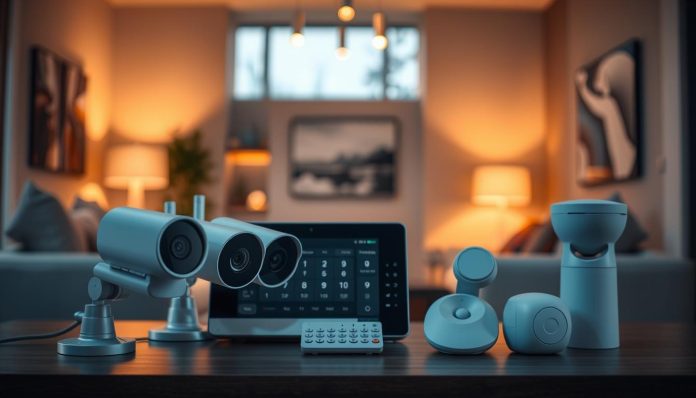If you want solid protection without a big upfront bill, this roundup helps you pick the right kit fast. We compare trusted brands like Ring, SimpliSafe, ADT Self Setup, Cove, and Abode so you can see what matters: loud sirens, fast alerts, and reliable monitoring.
You’ll learn which starter packs include the essentials—base station, entry sensors, motion detection, and at least one camera—and how each security system scales with add‑ons. Ring’s alarm sirens hit over 100 dB and send phone alerts in about four seconds. SimpliSafe installs in roughly 30 minutes and offers cellular and battery backup. ADT Self Setup links sensors to Nest cameras with quick texts on events.
We also preview monthly monitoring costs and privacy options so you know the total price of ownership. By the end you’ll have a shortlist of the best home security values and clear next steps to pick a DIY home security setup that fits your space and budget.
Why You Can Trust This Product Roundup Today
We tested each setup in real houses and controlled break‑in drills to show what performs when it matters. Our team logged more than 10,000 research hours, evaluated 60+ systems, and ran 150+ simulated break‑ins across U.S. homes.
Hands‑on testing matters: Wirecutter’s siren measurements and sub‑4‑second alert checks are part of the data set we used. We’ve tested Ring, SimpliSafe, ADT Self Setup, Cove, and Abode for install time, daily reliability, and response behavior.
We explain our methods — long installs, live trials, and response time checks — so you see why findings matter for your home. You’ll also get U.S.‑focused availability, monitoring options, and pricing insights.
- Privacy checks and two‑factor tests, not just marketing claims.
- Real alerts and agent response comparisons, including professional monitoring impacts.
- Reliability tests across internet and power disruptions so you know which systems stayed online.
How to Choose a Smart Home Security System on a Budget
Start by mapping real entry points so your defenses cover doors, main windows, and common paths.
Pick the devices that protect those spots first. Prioritize entry sensors, a motion detector for halls, and at least one indoor camera or video doorbell. This keeps initial costs down while covering the highest risk areas.
Compare reliability features. Look for kits with cellular backup, base station battery life, and internet failover so the system stays active during outages. SimpliSafe offers quick DIY setup in about 30 minutes and includes cellular and battery backup options.
Monitoring and ecosystem fit
Decide between app alerts and professional monitoring. Self‑monitoring saves money but professional monitoring adds video verification and alarm response. ADT Self Setup sends SMART monitoring texts fast and links to Nest cameras for richer event context.
- Cove keeps initial costs low with pre‑paired sensors.
- Ring delivers loud sirens and rapid alerts for deterrence.
- Abode supports wide integrations (HomeKit, Z‑Wave, Zigbee) for future expansion.
| Feature | Why it matters | Example |
|---|---|---|
| Coverage mapping | Targets real entry points to avoid overspending | Doors, key windows, halls |
| Reliability | Keeps system online during outages | Cellular backup, base battery |
| Monitoring options | Balances safety and monthly cost | Self‑alerts vs. professional monitoring |
Top Pick: Ring Alarm and Ring Alarm Pro Compared
For clear deterrence and a plug-and-play ecosystem, Ring Alarm gives most buyers the best mix of features and value.
What you get: Ring delivers deafening sirens (113 dB original, 104 dB Pro) and alerts in about four seconds. The ecosystem includes door/window sensors, glass‑break, leak detectors, and cameras so you can expand without complex bridges.
Ring Alarm Pro’s Eero Wi‑Fi 6 router and backup internet explained
The Pro model also includes an Eero Wi‑Fi 6 router and optional 24/7 AT&T backup with 3 GB included. Extra data runs about $3 per GB. The base station has a 24‑hour battery and supports add‑on power packs for longer uptime.
Pricing, monitoring plan options, and video storage at a glance
- Plans start around $10–$20, with professional monitoring as a $10 add‑on.
- Both plans include cellular backup and 180 days of video storage.
- Optional services: Virtual Security Guard ($99/month) and Alarm Guard Response ($75 per verified visit).
| Feature | Ring Alarm | Ring Alarm Pro |
|---|---|---|
| Router / Backup | Uses existing Wi‑Fi | Eero Wi‑Fi 6 + AT&T backup (3 GB incl.) |
| Battery life | Base station backup | 24‑hour base station + optional power packs |
| Monitoring & costs | $10–$20 plans; $10 add‑on for professional monitoring | Same plans; adds network backup and faster mesh Wi‑Fi |
Privacy and control: Ring mandates 2FA, offers Privacy Zones, and lets you dismiss alarms within 30 seconds to reduce false alarms. Integration is strong with Alexa and works with Google Home at a basic level, though third‑party support is limited.
SimpliSafe: Best DIY Installation and Monitoring for Under $500
SimpliSafe packs reliable DIY installation and flexible monitoring into a setup you can finish before lunch. Setup takes about 30 minutes, and the base kit also offers cellular backup and a base battery so your security system stays online during outages.
Monitoring plans are month-to-month. Standard runs about $21.99 per month. Core costs $31.99 per month and adds camera storage, video verification, and intruder intervention. Pro is $49.99 per month and includes active guard outdoor protection.
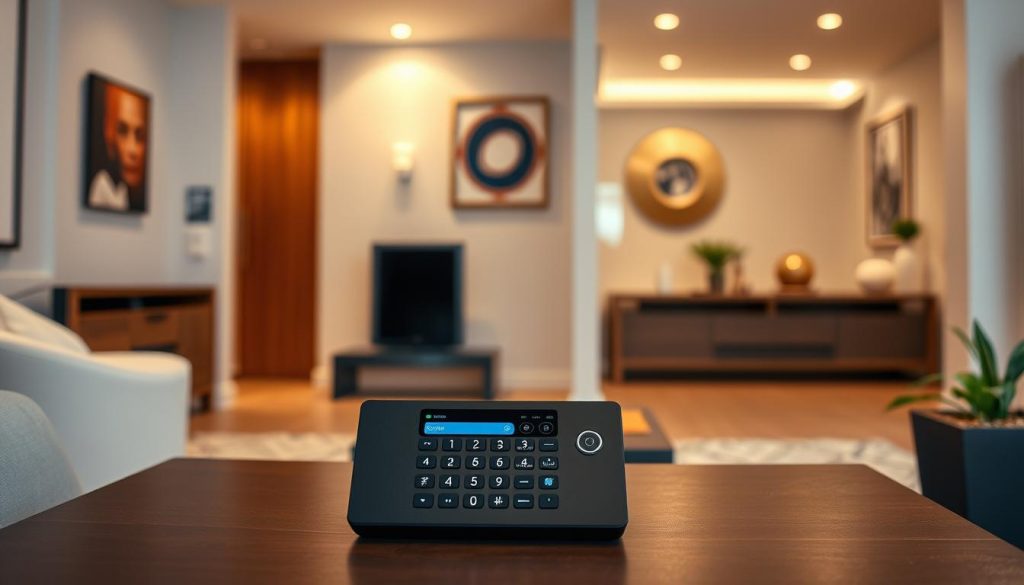
Intruder intervention uses the Wireless Indoor camera for agent talk-down during real alarms, which can deter intruders in seconds. Outdoor detections can be covered when you opt for Active Guard Outdoor or higher-tier plans.
- Fast alerts and straightforward sensor mounting (use screws, not just adhesive, for long-term holds).
- Camera options: indoor, outdoor, and video doorbell — recording requires cloud storage or a Fast Protect plan.
- Fewer niche accessories than some rivals, but strong core protection and flexible professional monitoring choices.
| Plan | Key features | Price (per month) |
|---|---|---|
| Standard | Self alerts, basic monitoring | $21.99 |
| Core | Camera storage, video verification, intruder intervention | $31.99 |
| Pro | Includes active guard outdoor protection and expanded verification | $49.99 |
ADT Self Setup: Best Equipment and Pro Monitoring Feel Without Pro Pricing
ADT Self Setup mixes ADT sensors with Google Nest cameras so you get sharp video and proven detectors without a field crew. The hub links to Nest features and works with Google Home devices for familiar routines.
SMART monitoring texts you within seconds so you can confirm or cancel alerts before an agent calls. ADT runs 12 monitoring centers and the workflow cuts false dispatches while speeding verified responses.
Plans are clear: Secure $24.99, Smart $29.99, and Complete $39.99 per month. The Complete tier includes Nest Aware and video verification, which matters if you want recorded clips and visual confirmation.
- DIY install: roughly 30 minutes; hub needs 2.4 GHz Wi‑Fi and remote help is available by video call.
- Pro monitoring feel: get agent support without a long contract or full professional installation.
- Scales easily: add sensors or Nest cameras as your needs grow.
| Plan | Key features | Cost per month |
|---|---|---|
| Secure | ADT sensors, basic monitoring | $24.99 |
| Smart | Includes camera support, faster texts | $29.99 |
| Complete | Nest Aware + video verification, priority response | $39.99 |
Trade-offs: it gives a near-professional feel, but if you need fully professionally installed hardware or hardwired sensors, a pro installation may still be best.
Cove: Most Affordable Customizable Starter Kits
Cove focuses on low up‑front costs and fast installs, so you can protect key entry points quickly.
Fast setup: Cove ships pre‑paired sensors that cut install time to about 30 minutes. That means doors, main windows, and hallways get covered fast without fuss.
Plans and pricing: Self‑monitoring runs $9.99 per month, Basic is $19.99 per month, and Plus is $29.99 per month. Most users should skip the $9.99 plan in favor of Basic or Plus for reliable alerts and response.
What Plus adds and trade‑offs
The Plus tier also offers camera support and voice control. Cove uses Eufy cameras, which require the Eufy app alongside Cove’s app — that dual‑app setup is a minor trade‑off for lower equipment prices.
- You’ll get quick installs with pre‑paired sensors and clear monitoring options.
- Frequent sales can push a starter kit well below $500 while covering core points.
- Expect a simpler feel and fewer automations compared with bigger ecosystems.
| Plan | Key feature | Cost |
|---|---|---|
| Self | DIY alerts | $9.99 per month |
| Basic | Professional monitoring option | $19.99 per month |
| Plus | Camera support & voice | $29.99 per month |
Overall, Cove is a strong value if you want affordable home security and clear monthly pricing. You can scale your security system over time while keeping initial costs low.
Abode: Flexible Monitoring Plans and Smart Home Features
Abode gives you modular hardware and flexible plans so you can tailor monitoring to your budget and tech stack.
Abode supports several hubs, including the iota all‑in‑one with a built‑in camera. That makes the iota handy in tight spaces where you want both a hub and visual coverage.
The system links with Alexa, Google Home, and Apple HomeKit. It also supports Z‑Wave and Zigbee devices. This broad compatibility helps unify many smart devices and routines.
You can self‑monitor for free or pick premium monitoring plans for added features. Consider professional monitoring if your internet is unreliable, because premium self‑monitoring lacks cellular backup.
- When to go pro: choose professional monitoring if you want redundancy during outages or faster verified response.
- What to watch for: Abode doesn’t include native smoke/CO detectors, so plan compatible third‑party sensors if you need those protections.
- Best fit: Abode shines if you want expansive integrations and automation flexibility while keeping monthly costs in check.
| Aspect | What Abode offers | Practical note |
|---|---|---|
| Monitoring plans | Free self‑monitoring; paid tiers for cloud, automation, pro monitoring | Paid tiers add features; self plan is limited without cellular backup |
| Hub options | Multiple hubs including iota (built‑in camera) | Iota is space‑saving but may increase kit cost |
| Integrations | Alexa, Google Home, Apple HomeKit, Z‑Wave, Zigbee | Great for expanding devices and creating routines |
| Missing items | No native smoke/CO hardware; limited cellular fallback on some plans | Add compatible detectors and consider pro monitoring if needed |
Smart Home Security Kits Under $500 That Don’t Skimp on Protection
These top picks balance upfront cost and real-world performance so you get strong coverage for less.
Quick shortlist — best value now:
- Ring Alarm (original) — best if you want the loudest siren and fastest phone alerts. Good out-of-the-box sensor coverage; add a doorbell camera later.
- SimpliSafe — best for fast DIY setup and flexible monitoring. Kits include base station, keypad, and multiple sensors; upgrade plans give video storage and verification.
- ADT Self Setup — best for text-first monitoring and Nest camera quality. Starter packs pair solid sensors with easy camera add-ons.
- Cove — best for lowest upfront cost. Pre‑paired sensors simplify install; add cameras later if you need video.
- Abode — best for broad integrations (HomeKit, Z‑Wave, Zigbee). Hubs often include built-in cameras for tighter coverage.
Pick a monitoring plan that matches your internet reliability and budget. Start with basic professional monitoring or self-monitoring plus cloud video for core coverage. Upgrade if you need video verification, cellular backup, or faster agent response.
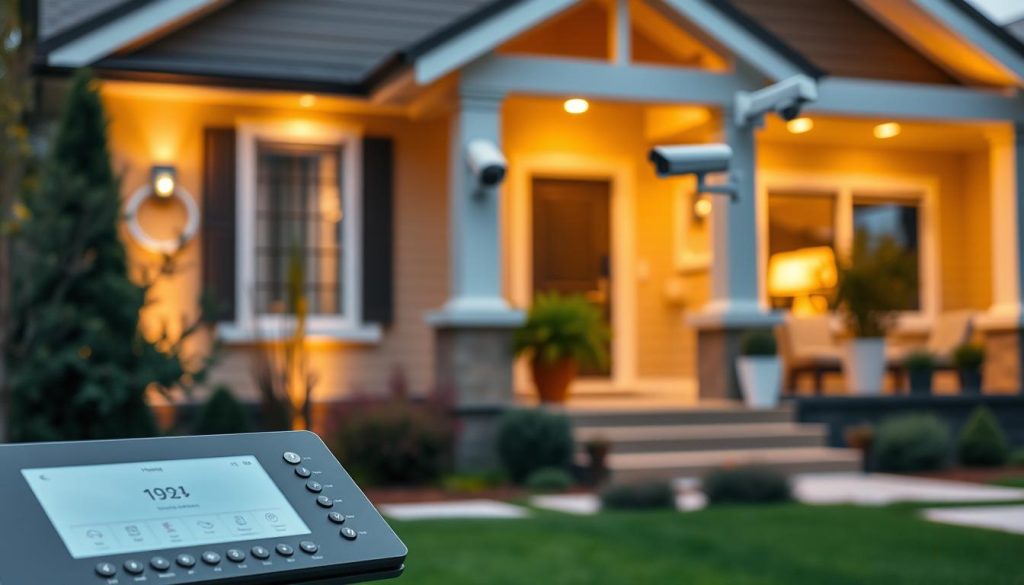
| Pick | Best for | Out-of-box coverage | Start monitoring plan |
|---|---|---|---|
| Ring Alarm (original) | Loud siren, rapid alerts | Base, keypad, 3–5 sensors | Ring Protect or basic pro monitoring |
| SimpliSafe | DIY install, flexible plans | Base, keypad, motion, entry sensors | Standard or Core for cameras |
| ADT Self Setup | Text-first verification, Nest video | ADT hub + sensors; camera optional | Secure or Smart for video |
| Cove | Lowest upfront cost | Pre-paired sensors + base | Basic plan for pro monitoring |
| Abode | Integrations & automation | Hub (some include camera) + sensors | Free self-monitor or paid pro plan |
DIY Home Security vs. Professionally Installed Systems
Deciding between a DIY install and a pro crew comes down to house size, wiring, and how much help you want. Many modern kits let you set up in under an hour and still deliver solid protection.
When to DIY: choose a DIY home approach if your floorplan is simple, you rent, or you want lower start‑up costs. SimpliSafe and ADT Self Setup took roughly 30 minutes in our tests. Cove ships pre‑paired sensors for fast installs. Abode averaged about 45 minutes.
When to hire pro help: consider professional installation for large homes, complex wiring, or legacy systems. ADT’s pro installs often come with higher monitoring rates and longer contracts than their Self Setup option.
- Timing: expect 30–45 minutes; doorbell wiring or battery swaps add time.
- Cost & flexibility: DIY = month‑to‑month; pro installs often tie you to contracts.
- Support: use remote assistance if you want guidance without full pro fees.
| Choice | Best fit | Key trade‑off |
|---|---|---|
| DIY | Renters, small homes | Lower cost, flexible plans |
| Professional | Large/complex homes | Higher reliability, higher monthly fees |
| Remote assist | Do‑it‑yourself with help | Guidance without a full pro contract |
Both paths now offer quality gear. You can get pro‑grade components in affordable packages. Compare your monitoring options and pick what fits your budget and peace of mind.
Integrations: Alexa, Google Home, and Your Existing Smart Home
Voice assistants can turn simple alarm commands into daily routines you’ll actually use. Start by checking which platforms your gear supports and how much control you get without opening apps.
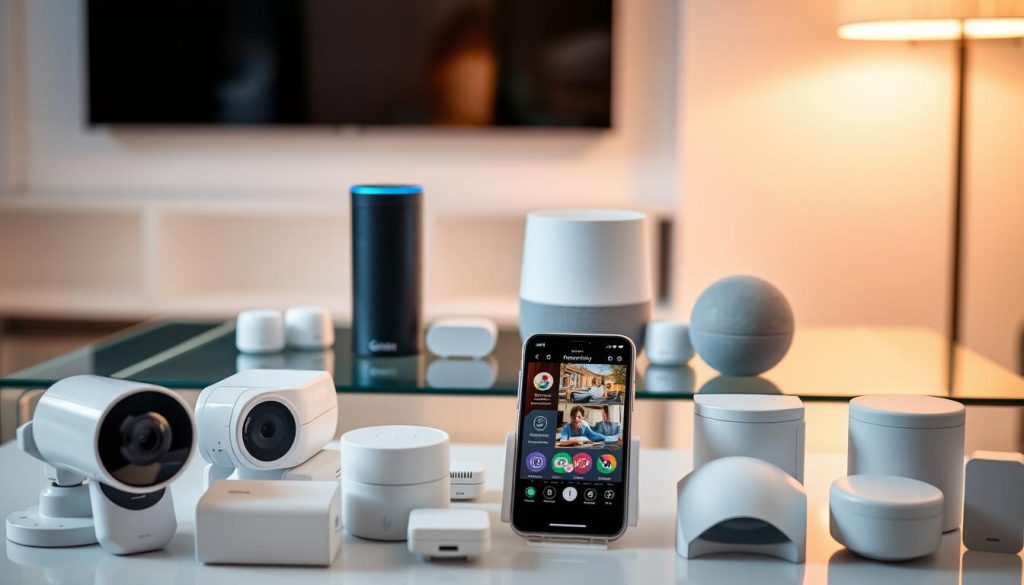
Where each system fits
Ring leans into Alexa with the deepest skill set and a Works with Ring program. SimpliSafe supports both Alexa and Google Home for basic voice arming and camera views.
ADT Self Setup ties tightly to Google Nest devices, making Google Home the obvious pick if you use Nest cams. Cove Plus adds voice control on higher tiers. Abode covers Alexa, Google Home, and Apple HomeKit, plus Z‑Wave and Zigbee for broad device support.
- Voice control common uses: arm/disarm, view camera feeds, and trigger lights or announcements.
- What still needs the app: account management, alarm cancellations, and some advanced settings.
- Automation tips: use geofencing and timed routines, but keep notifications focused to avoid alert fatigue.
| System | Voice support | Key note |
|---|---|---|
| Ring | Alexa | Alexa-forward; Works with Ring ecosystem |
| SimpliSafe | Alexa, Google Home | Basic arming & camera commands |
| Abode / ADT / Cove | Alexa, Google Home, HomeKit (Abode) | Best for broad integrations and future expandability |
Monitoring Plans and Monthly Fees: What You’ll Actually Pay per Month
Monthly costs matter as much as the gear — here’s how much you’ll pay to keep your system watched. This section breaks down typical per month charges so you can pick the right monitoring plan for your needs.
Self-monitoring vs. professional monitoring options
You can self‑monitor to save money or choose professional monitoring for vetted response. Self plans often cut the monthly fee but shift responsibility to you.
Examples: Ring ranges $10–$20 per month; add $10 for professional monitoring. SimpliSafe’s tiers start at $21.99 and go to $49.99 per month for Pro. ADT Self Setup runs $24.99–$39.99 per month depending on features.
Cellular backup, video storage, and add-ons that add up
Look for cellular backup and included video storage before you commit. Ring includes 180 days of video storage on some plans and offers 24/7 internet backup (3 GB included) as a paid extra.
SimpliSafe’s Core adds video storage and intruder intervention; Cove’s Plus adds camera support for an extra monthly fee. Abode offers free self‑monitoring but premium tiers can add cloud features without cellular backup.
| Brand | Typical monthly fee | Notes |
|---|---|---|
| Ring | $10–$20 per month | 180 days video storage on plans; $10 add‑on for professional monitoring |
| SimpliSafe | $21.99–$49.99 per month | Core adds video storage & intervention; Pro adds outdoor protection |
| ADT Self Setup | $24.99–$39.99 per month | Top tier includes Nest Aware and video verification |
Core Hardware Checklist: Base Station, Security Cameras, Video Doorbell, and Sensors
Build a reliable kit by starting with the gear that actually stops intrusions and proves events.
Must-have items: a base station, keypad, entry sensors, a motion sensor, and at least one camera or video doorbell to cover main doors and halls.
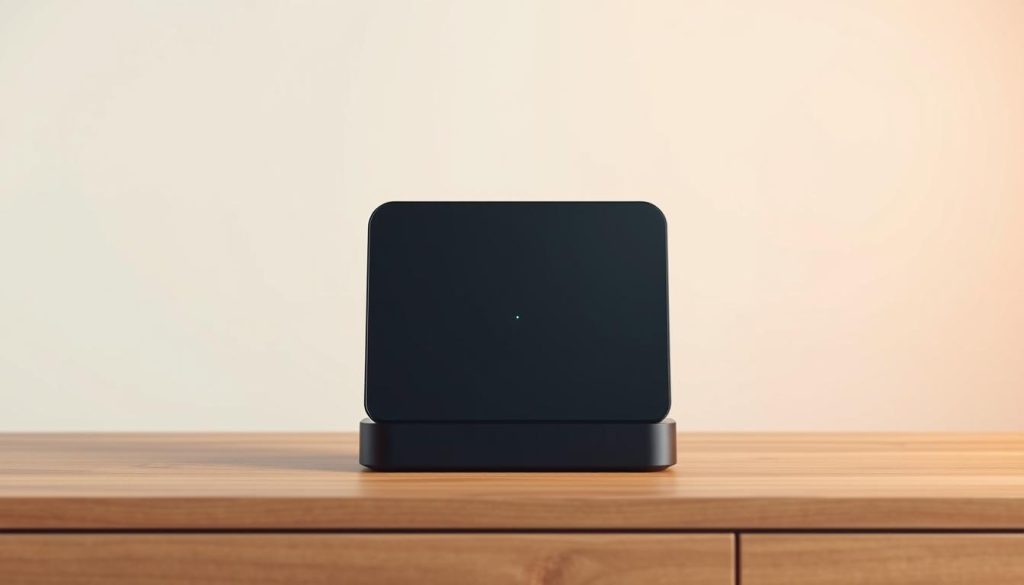
The base station coordinates devices and sends alerts. Pick a hub with battery backup and cellular failover when possible. Ring’s base station includes 24‑hour battery backup and options for power packs; the Pro adds an Eero router for network resilience.
Indoor security cameras give verification inside. A video doorbell records front-door traffic and helps spot deliveries. SimpliSafe, ADT (Nest cameras), Cove (pre‑paired sensors), and Abode (iota hub with built‑in camera) each take a different approach, so buy to fit your layout.
- Place motion sensors in hallways and main paths to limit false triggers.
- Add a second camera if you have multiple high-traffic entry points; otherwise add entry sensors to each door and key window.
- Fast setup tips: label devices, test chimes, and confirm each device reports to the base station.
| Item | Why it matters | Example |
|---|---|---|
| Base station | Central hub, backup power, cellular | Ring base; Abode iota |
| Video doorbell | Front‑door verification | SimpliSafe doorbell; Nest doorbell |
| Motion sensor | Detects hall/common paths | Ceiling or corner mounted |
Start with this starter build and you’ll have a strong home security foundation that leaves room to grow your system later.
Safety Add‑Ons That Matter: Smoke Alarm, Carbon Monoxide, and Environmental Sensors
Life‑safety sensors do more than warn about break‑ins — they alert you to fire, gas, and water risks so you can act fast.
Why pair detectors with your home security gear: a smoke alarm and carbon monoxide detector linked to your base brings life‑saving alerts to your phone and to a monitoring service for faster dispatch.
Ring supports Kidde Ring Smart Smoke and the combined Smoke & CO models, and it also sells a Smoke & CO Listener that ties legacy alarms into your security system. Abode lacks native smoke/CO units but integrates many third‑party detectors. SimpliSafe and Cove offer environmental sensors (water, freeze) in their catalogs.
- Use a listener to bridge hardwired alarms for a budget‑friendly upgrade.
- Place detectors outside bedrooms and on each level; test monthly.
- Link signals to routines (lights, announcements) for faster awareness.
| Brand | Included sensors | Practical note |
|---|---|---|
| Ring / Kidde | Smoke & CO options + listener | Works with monitoring service and app alerts |
| SimpliSafe | Smoke, CO, water options | Sold as add‑ons in kits for staged upgrades |
| Abode | Third‑party support | Integrates widely; add detectors via bridges |
Pro tip: choose professional monitoring for automatic CO dispatch if you want extra peace of mind. Also check google home compatibility if voice routines matter to you.
Reducing False Alarms and Improving Response
You can cut false alarms and speed real help with a few simple adjustments. Small changes to device placement, delay settings, and verification options protect your family and reduce unnecessary dispatches.
Motion sensor placement and practical tweaks
Place a motion sensor in hallways and main entry paths so movement is tracked where it matters. Avoid pointing sensors at vents, windows, or low shelves where pets, drafts, or sunlight will trigger them.
Test sensors monthly and label each zone so you know which device tripped. Adjust entry/exit delays and chime settings to match your routine and cut accidental alerts.
Video verification and agent-assisted deterrence
Video verification speeds police response on compatible monitoring plan tiers. ADT SMART texts you within seconds to confirm or cancel alerts, and Ring lets you dismiss alarms within 30 seconds to avoid a call.
SimpliSafe’s intruder intervention uses agent talk‑down through an indoor camera to deter intruders and document events for responders.
- Enable verification where available.
- Keep cameras aimed for quick ID, not privacy zones.
- Follow a three-step quick response: verify, call if needed, and note zone labels for responders.
| Action | Why it helps | Who benefits |
|---|---|---|
| Better placement | Fewer accidental triggers | Your household |
| Video verification | Faster confirmed response | Monitored accounts |
| Agent deterrence | Stops intruders and records events | Professional monitoring users |
Outdoor Protection: Cameras, Floodlights, and Active Guard‑Style Features
A well-placed camera and floodlight can turn a dark porch into a clear, recorded space that deters prowlers. An outdoor camera plus bright lighting raises visibility and forces suspicious activity into view before someone reaches your door.
Ring offers a wide line of security cameras and lights built to withstand weather and glare. ADT Self Setup supports the google nest Cam with floodlight for broad coverage near driveways and porches. Cove uses Eufy outdoor cams while SimpliSafe’s Pro tier adds active guard outdoor tools to involve agents when needed.
Active guard outdoor and similar guard outdoor protection give monitored accounts a response layer: agents can verify detections and speak through devices to discourage loitering. These features usually require a paid plan, so factor subscription costs into your budget.
Mount cameras for a downward angle that captures faces and plates while avoiding direct sun or porch lights that cause false triggers. Place floodlights above entryways and angle them so motion triggers the beam, not passing cars.
- Tune motion zones and sensitivity to cut alerts from street traffic.
- Pair schedules and lights to simulate occupancy at night.
- Start with one good camera and one floodlight, then expand the security system as you save.
| Brand | Outdoor gear | Deterrence feature |
|---|---|---|
| Ring | Weatherproof cams, floodlights | Sirens, two-way audio |
| SimpliSafe | Eufy/partner cameras (Pro adds) | Active Guard Outdoor agent engagement |
| ADT Self Setup | google nest Cam with floodlight | Quick texts + video verification |
| Cove | Eufy outdoor cameras | Basic motion lights; camera recording |
Conclusion
This wrap-up gives you a quick, practical path to pick a reliable system that fits your budget and daily routine.
Today’s top value picks — Ring Alarm (and Pro), SimpliSafe, ADT Self Setup, Cove, and Abode — cover loud sirens, fast alerts, strong monitoring, or broad integrations. Choose a starter build with a base station, entry sensors, and at least one camera or doorbell to start.
Decide if you want to self-monitor or pay for professional monitoring options. Factor monthly costs for storage, verification, and backup internet before you buy. If you’re looking for the best smart home balance, Abode and Ring give easy expansion paths.
Final checklist: buy the kit that matches your floor plan, test sensors monthly, update apps, and tune zones to cut false alarms. With the right selection, affordable home security doesn’t mean weak coverage.
